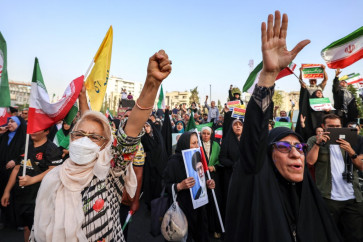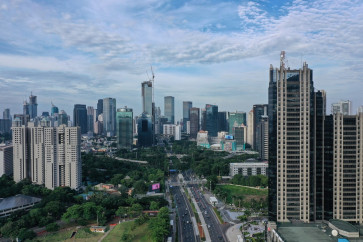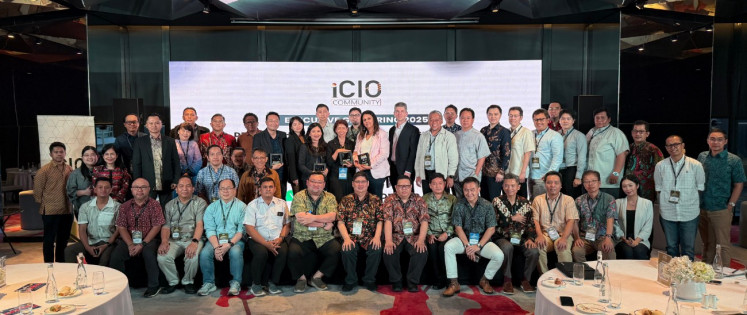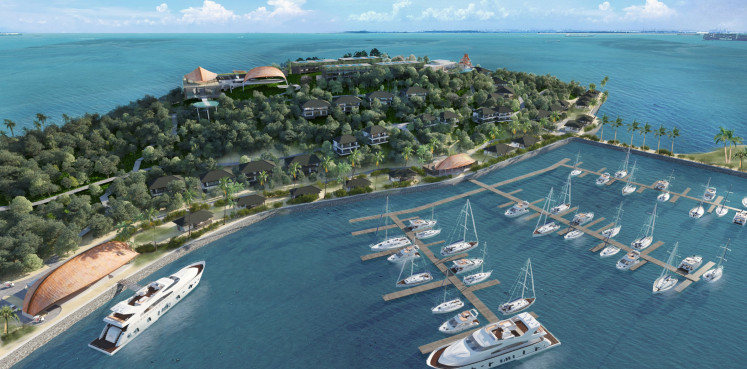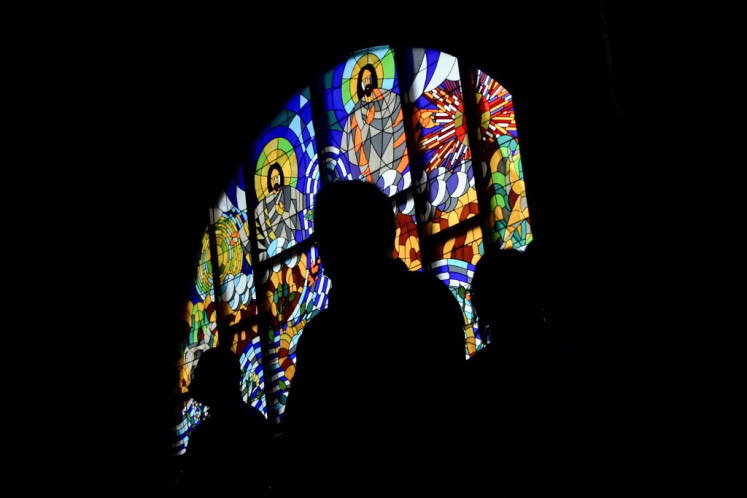Popular Reads
Top Results
Can't find what you're looking for?
View all search resultsPopular Reads
Top Results
Can't find what you're looking for?
View all search resultsFuji Electric offers comprehensive sustainable energy solutions
(Photos courtesy of The Jakarta Post)PT Fuji Electric Indonesia, a subsidiary of Japan-based Fuji Electric Co
Change text size
Gift Premium Articles
to Anyone
 (Photos courtesy of Fuji Electric)" height="337" border="0" width="636">(Photos courtesy of The Jakarta Post)
(Photos courtesy of Fuji Electric)" height="337" border="0" width="636">(Photos courtesy of The Jakarta Post)PT Fuji Electric Indonesia, a subsidiary of Japan-based Fuji Electric Co. Ltd., has diversified its business from a mere supplier of electrical components to offering comprehensive sustainable energy solutions to its customers in Indonesia.
The company, which has been operating for three years in Indonesia, specializes in power-related electronic and industrial systems, such as drives, uninterruptible power supply (UPS) units, plant engineering and electrical distribution as well as control components.
The demand for efficient energy equipment, which produces smaller amounts of carbon dioxide, has been on the rise recently due to concerns about global warming brought about by the generation of millions of tons of carbon dioxide.
Soaring energy costs and a power supply that has increasingly been unable to meet high demand for it are also the impetus for many countries to push for the development of sustainable energy to support industrial and economic growth.
According to University of Tokyo professor Motoyoki Suzuki, sustainable energy is essential to reduce energy costs, boost company profits and business competitiveness, which has led to the rising demand for renewable energy from industry.
Recognizing the importance of this effort, the Indonesian government has also aimed at increasing Indonesiaâs share of renewable energy to 25 percent in 2025.
Renewable energy sources
Renewable energy sources come in different forms. Geothermal, photovoltaic and wind-generated power are just three of them. Each of these renewable energy sources has its own advantages and disadvantages.
Geothermal energy is a thermal energy generated and stored in the Earth. It is an advantageous power source in a sense that it can be used 24 hours a day, without any interruption. However, limitations in development areas as well as huge drilling costs have posed challenges to the exploration of geothermal power sources so far.
Indonesia has huge geothermal resources scattered in Ulubelu, Lampung; Salak, West Sumatra; Wayang Windu, West Java; Lahendong, North Sulawesi and Kamojang, West Java. The country ranked second in the worldâs richest geothermal sources with a total potential of 29,038 megawatts (MW).
Out of the whole energy potential, however, only 1,226 megawatts or some 4 percent has been utilized so far. Indonesiaâs location on the Ring of Fire has posed further challenges to the exploration of this energy source.
Meanwhile, the photovoltaic energy source, which uses solar power as its main propellant, is also advantageous for Indonesia considering the countryâs location on the equatorial line. Its advantages rest on the static nature of its power generation, reducing maintenance time and effort. Furthermore, the generators can be installed anywhere.
The disadvantage of this power source lies in the fluctuations brought about by weather changes.
Indonesia also has strong wind power potential.
âWe have a hybrid system generating power from multiple renewable energy sources to ensure the constant availability of power despite the limitations of each renewable source. We also use the hybrid energy storage system to function both stabilize power and peak-shaving,â Fuji global office sales group project promotion department senior manager Keisuke Ogawa said during the companyâs recent Innovation Forum 2015 for the Realization of Sustainable Society seminar.
Fuji Electric also has a micro-grid system that could decentralize energy from these sources. Decentralized energy is generated or stored by a variety of small, grid-connected devices that are referred to as distributed energy resources (DER) or distributed energy resource systems.
(Photos courtesy of The Jakarta Post)
Power stabilization solutions
Fuji Electric also offers power energy-efficient stabilization equipment in order to help industries resume their operations despite power drops and grid outages while saving energy costs.
The companyâs co-generation system helps customers to reduce their energy costs by providing highly efficient power generated from heat. The system utilizes gas turbines to generate heat and steam from hot water, which subsequently will be used to keep operations running.
The equipment also has a voltage-drop compensator, which is necessary to prevent equipment damage in case of electric blackouts.
The company also has a pilot project of their stabilization equipment in a factory located in the Suryacipta industrial area in Karawang, Bekasi, West Java.
âWe completed our tryout project in Indonesia, considering that power shortages in Indonesia usually last for a very long time, thereby disrupting productivity. By using the efficient power generation system, Indonesia could actually increase its economic growth brought about by increased productivity,â Fuji Electric power and social infrastructure business group smart community grand design department chief expert Masao Nakamura said.
They tried out their distributed automation system (DAS) equipment, which minimizes power outage time in order to prevent blackouts from disrupting productivity, in the factory.
During the companyâs tryout project in that factory, the DAS equipment was used hand-in-hand with the co-generation system. DAS is used to increase availability while the co-generation system is used to save energy.
Fuji Electric itself has 35 years of experience in developing the equipment and controls some 20 percent of market share for it in Japan.
(Photos courtesy of The Jakarta Post)<)
(Photos courtesy of The Jakarta Post)
PT Fuji Electric Indonesia, a subsidiary of Japan-based Fuji Electric Co. Ltd., has diversified its business from a mere supplier of electrical components to offering comprehensive sustainable energy solutions to its customers in Indonesia.
The company, which has been operating for three years in Indonesia, specializes in power-related electronic and industrial systems, such as drives, uninterruptible power supply (UPS) units, plant engineering and electrical distribution as well as control components.
The demand for efficient energy equipment, which produces smaller amounts of carbon dioxide, has been on the rise recently due to concerns about global warming brought about by the generation of millions of tons of carbon dioxide.
Soaring energy costs and a power supply that has increasingly been unable to meet high demand for it are also the impetus for many countries to push for the development of sustainable energy to support industrial and economic growth.
According to University of Tokyo professor Motoyoki Suzuki, sustainable energy is essential to reduce energy costs, boost company profits and business competitiveness, which has led to the rising demand for renewable energy from industry.
Recognizing the importance of this effort, the Indonesian government has also aimed at increasing Indonesia's share of renewable energy to 25 percent in 2025.
Renewable energy sources
Renewable energy sources come in different forms. Geothermal, photovoltaic and wind-generated power are just three of them. Each of these renewable energy sources has its own advantages and disadvantages.
Geothermal energy is a thermal energy generated and stored in the Earth. It is an advantageous power source in a sense that it can be used 24 hours a day, without any interruption. However, limitations in development areas as well as huge drilling costs have posed challenges to the exploration of geothermal power sources so far.
Indonesia has huge geothermal resources scattered in Ulubelu, Lampung; Salak, West Sumatra; Wayang Windu, West Java; Lahendong, North Sulawesi and Kamojang, West Java. The country ranked second in the world's richest geothermal sources with a total potential of 29,038 megawatts (MW).
Out of the whole energy potential, however, only 1,226 megawatts or some 4 percent has been utilized so far. Indonesia's location on the Ring of Fire has posed further challenges to the exploration of this energy source.
Meanwhile, the photovoltaic energy source, which uses solar power as its main propellant, is also advantageous for Indonesia considering the country's location on the equatorial line. Its advantages rest on the static nature of its power generation, reducing maintenance time and effort. Furthermore, the generators can be installed anywhere.
The disadvantage of this power source lies in the fluctuations brought about by weather changes.
Indonesia also has strong wind power potential.
'We have a hybrid system generating power from multiple renewable energy sources to ensure the constant availability of power despite the limitations of each renewable source. We also use the hybrid energy storage system to function both stabilize power and peak-shaving,' Fuji global office sales group project promotion department senior manager Keisuke Ogawa said during the company's recent Innovation Forum 2015 for the Realization of Sustainable Society seminar.
Fuji Electric also has a micro-grid system that could decentralize energy from these sources. Decentralized energy is generated or stored by a variety of small, grid-connected devices that are referred to as distributed energy resources (DER) or distributed energy resource systems.
(Photos courtesy of The Jakarta Post)
Power stabilization solutions
Fuji Electric also offers power energy-efficient stabilization equipment in order to help industries resume their operations despite power drops and grid outages while saving energy costs.
The company's co-generation system helps customers to reduce their energy costs by providing highly efficient power generated from heat. The system utilizes gas turbines to generate heat and steam from hot water, which subsequently will be used to keep operations running.
The equipment also has a voltage-drop compensator, which is necessary to prevent equipment damage in case of electric blackouts.
The company also has a pilot project of their stabilization equipment in a factory located in the Suryacipta industrial area in Karawang, Bekasi, West Java.
'We completed our tryout project in Indonesia, considering that power shortages in Indonesia usually last for a very long time, thereby disrupting productivity. By using the efficient power generation system, Indonesia could actually increase its economic growth brought about by increased productivity,' Fuji Electric power and social infrastructure business group smart community grand design department chief expert Masao Nakamura said.
They tried out their distributed automation system (DAS) equipment, which minimizes power outage time in order to prevent blackouts from disrupting productivity, in the factory.
During the company's tryout project in that factory, the DAS equipment was used hand-in-hand with the co-generation system. DAS is used to increase availability while the co-generation system is used to save energy.
Fuji Electric itself has 35 years of experience in developing the equipment and controls some 20 percent of market share for it in Japan.
(Photos courtesy of The Jakarta Post)
Green and smart data center
Data centers are essential for today's business, and Indonesia is the most possible and attractive market in Southeast Asia with the greatest unfulfilled potential. Internet of Things will dramatically raise the number of servers which results in the increase of total necessary power to cool servers. Annual power consumption from 2013 to 2020 will increase by 340 Trillion Wh which is equal to 330 nuclear power plants.
According to Fuji electric sales group global plant division assistant manager Tomohiko Nakanishi, the company offers indirect outside air-conditioning unit 'F-COOL NEO', a hybrid cooling control system combining outside air with refrigeration, which helps to produce cool air with high energy efficiency and minimizing power consumption to cool servers.
'The combination unit helps to reduce power usage of heat source about 33 percent than general air conditioning unit. We can provide most attractive PUE (Power Usage Effectiveness) for your data center,' he said.
The company also provides one-stop solutions for data centers combining air conditioning, high efficiency UPS and power controlling system. They can also provide the most suitable solutions for such a specific demand in Indonesia by supplying scalable and transportable data center system.

